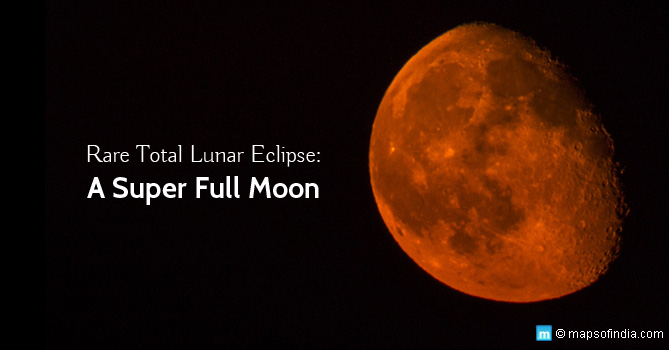On September 28, 2015, a rare total lunar eclipse of a Super Full Moon was visible from most of North America, South America, Europe, West Asia and parts of Africa. The Lunar Eclipse on September 27/ 28, 2015 occurred during the Harvest Moon in the Northern Hemisphere. The Harvest Moon is the Full Moon closest to the September Equinox and is astronomically significant. The Full Moon is referred to as a Super Moon because the Moon will be the closest to the Earth as it turns into a Full Moon and thus will seem brighter and larger. This lunar eclipse is the fourth and the final one of an ongoing lunar tetrad. Four successive total lunar eclipses, with no partial lunar eclipses in between, are known as a lunar tetrad. Each eclipse is separated from the other by six lunar months (six full moons). The other three lunar eclipses occurred on April 15, 2014; October 8, 2014; and April 4, 2015.
What is a Lunar Eclipse?
We all know that the Moon does not have any light of its own. It just reflects the light of the Sun. Lunar eclipse occurs when the Earth comes in between the Sun and the Moon, creating a shadow and blocking the light of the Sun from reaching the Moon. There are three kinds of lunar eclipses:
Partial: In this eclipse, though the Earth comes between the Sun and the Moon, they do not form a perfectly straight line and thus a part of the Moon still reflects the light of the Sun.
Penumbral: This eclipse occurs when the Sun, the Earth and the Moon align in an almost straight line and the Earth itself covers a small part of the Moon with the outer part of its shadow also known as the penumbra.
Total: The most dramatic of the three kinds of eclipses; in this phenomenon, the three celestial bodies are in a perfect straight line and the Earth’s full (umbra) shadow falls on the Moon. The darkness is not complete but is replaced by an eerie light.
Blood Moon
Blood Moon occurs during the total lunar eclipse. Sometimes, the Moon may seem red or coppery even while, in the shadow of Earth, a certain amount of light is refracted towards the Moon from the atmosphere of Earth. The red light in the spectrum makes it through, to reach the Moon, while the other colours get scattered. The colour red is the same phenomenon that applies to the sunrise and the sunset.
According to the NASA scientists, “The exact colour that the moon appears depends on the amount of dust and clouds in the atmosphere. If there are extra particles in the atmosphere, from say a recent volcanic eruption, the moon will appear a darker shade of red.”
The Myths behind Blood Moon
It is believed by some that the term ‘Blood Moon’ originates from the Bible. In recent years, the term ‘Blood Moon’ has been frequently used to refer to total lunar eclipses. Some sources suggest that the term stems from the Bible. The myths that are attached to the Blood Moon are as follows:
- The phenomenon of Blood Moon has occurred seven times since the birth of Jesus Christ.
- The first four had significance to Jewish and Christian people.
- The two Christian pastors, Mark Blitz and John Hagee, believe that this tetrad represents a fulfillment of a Biblical prophecy.
- As per this prophecy, the completion of the lunar tetrad will see the beginning of difficult times for the World.
- To add to the belief of these pastors, the eclipses in the tetrad coincided with important Jewish festivals.
- While in April 2014 and April 2015, Blood Moon occurred during Passover; in October 2014 and September 2015, the eclipses occurred during the Feast of Tabernacles.
- Some believe that this coincidence is just a sign of end of times to come with an incredible impact on Christians as well.
Scientists’ Point of View
Scientists have dismissed any apocalyptic significance of the tetrad. According to them:
- Data of past eclipses show that at least eight lunar tetrads have coincided with Jewish holidays since the First Century.
- Passover always occurs around a Full Moon.
- A total lunar eclipse can occur only during Full Moon. Thus it is only normal that an eclipse will coincide with Passover.
- The colour red is also because of a scientific phenomenon. As per this phenomenon, during the total eclipse, the colour red from the spectrum is refracted towards the surface of the moon rendering it the same colour.
Conclusion
Total eclipses of Super Full Moons are rare. According to NASA, they have only occurred five times in the 1900s – in 1910, 1928, 1946, 1964 and 1982. So if you have missed the September 27/ 28, 2015 Total Lunar Eclipse, you will now have to wait for 18 more years to observe the splendid sight of the Blood Moon, for the next Super Moon eclipse will occur only on October 8, 2033.






